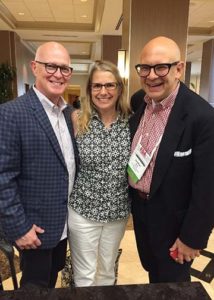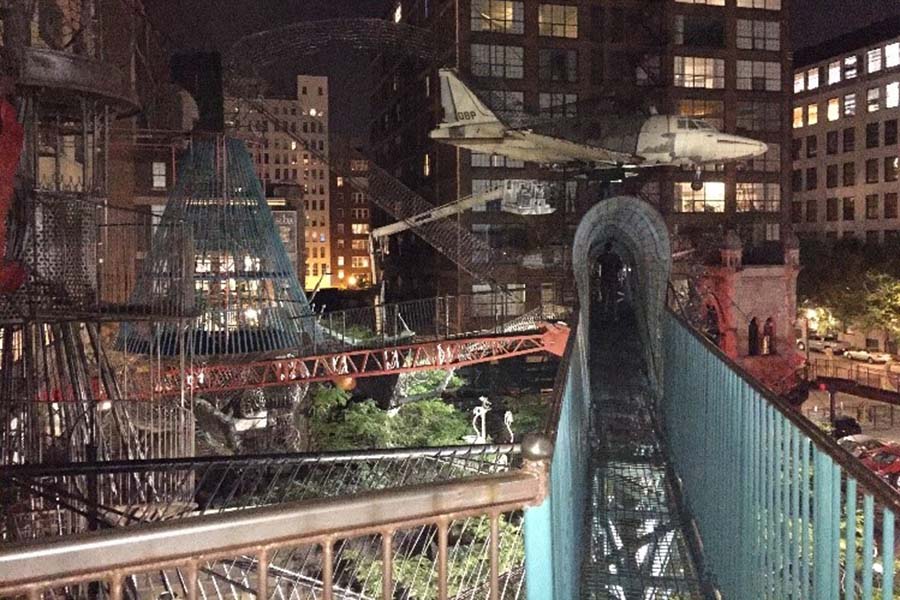With the “Gateway to the West” arch glistening just outside several of our meeting spaces, St. Louis made a beautiful place for the 2018 Theatre Communications Group Conference, June 14-16. Sure, there was a heat wave, and the Cubs were in town to trounce the home team, but most of us paid no mind. We were too busy going to plenaries, breakout sessions and networking events, all to discuss our shared passion: theatre.
I am continually amazed by the sheer number of people in attendance at TCG’s informative and entertaining events. Outside the world of theatre artists and managers, it’s rare to find someone who understands what I do for a living. When I say I work in theatre management, I often get, “Are you an actress?” Yet, at the annual conference, there are hundreds of people from across the nation who do the same job I do, more or less. It’s easy to forget how broad our field is during the daily grind. So what a joy it is to totally geek out with colleagues for a full weekend.
There were so many events to choose from, I spent what felt like hours just reading through the options. Kudos go to TCG’s Devon Berkshire, director of conferences and fieldwide learning, and Hannah Fenlon, associate director of same, for their amazing feat of organizing such a broad range of stimulating topics and the endless logistics involved. A handy app made it easier to organize my days, but the challenge was deciding between, say, “Citizen Leaders: When Theatres & Civic Leaders Forge Meaningful Relationships” and “A Diminished Incentive: The Impact of the New Tax Law on Individual Charitable Giving.” (In this case, I chose the latter, but more on that later.)

of the executive search firm Management Consultants for the Arts.
As I was making my choices, I found myself faced with a kind of moral dilemma: Should I go to the sessions that my friends and colleagues were presenting to support them, even if I felt attracted by other workshops being offered at the same time? I decided that the answer was yes, support my friends—and I ended up learning more than I expected to.
As I work for a theatre that recently completed a CEO search, I was glad to attend Management Consultants for the Arts (MCA) trend workshop, “Pulling Back the Curtain on the Search Process.” With the current American theatre leadership “musical chairs” being the hot topic of TCG’s Fall Forum on Governance last November, this session addressed what happens behind the scenes when a big search is underway. The presentation, however, felt like it could have been part of the conference’s “skills building workshop” track, due to its emphasis on how to be a successful leadership candidate. Included were tips on how high your laptop should be positioned for a FaceTime interview (eye level) and how to manage a lunch interview (don’t eat). The most emphatic piece of advice: “Answer the question, and then stop talking.”
What I was more interested in is the lack of diversity in the field’s current and new leadership. Stephen Richard broached the subject, cautioning, “Gender parity and racial diversity are not the same thing.” Regarding the pipeline into leadership positions, he said, “As a field, we’re doing better with gender parity than we are with racial diversity. We have a long way to go.” All candidates, regardless of gender or race, are evaluated against the same criteria, he said. MCA is seeing more openness on the clients’ part in artistic leadership searches than in management searches. I asked how much they, as consultants, advise in decision-making, or if they restrict themselves to guiding the client through the process. Richard said that they serve in both roles, but toward the end of the process they back away from offering opinions on the candidates, because ultimately it’s the search committee’s choice, not theirs.
After lunch the same day and the following morning, conference attendees were able to take advantage of confidential one-on-one consultation sessions. David Mallette reported that he, Richard, and Jonathan West “were chatting non-stop with folks.” What a great resource that was for participants.
 Another workshop hosted by colleagues was “Master Planning Made Simple,” presented by Mark Vicente, an architect with Princeton, N.J.-based Mills + Schnoering Architects, and Sarah Martin from Stages Consultants. My takeaway was that in fact master planning is anything but simple! Still, Vicente and Martin did a great job explaining why a facility master plan is the critical first step when planning a capital improvement or construction project. They used my current place of employment, the historic State Theatre New Jersey in New Brunswick, as a case study, and shared elements of the research they conducted, staff interviews they held, lists they made, including “needs” vs. “wants,” and floor plans and renderings developed during the process.
Another workshop hosted by colleagues was “Master Planning Made Simple,” presented by Mark Vicente, an architect with Princeton, N.J.-based Mills + Schnoering Architects, and Sarah Martin from Stages Consultants. My takeaway was that in fact master planning is anything but simple! Still, Vicente and Martin did a great job explaining why a facility master plan is the critical first step when planning a capital improvement or construction project. They used my current place of employment, the historic State Theatre New Jersey in New Brunswick, as a case study, and shared elements of the research they conducted, staff interviews they held, lists they made, including “needs” vs. “wants,” and floor plans and renderings developed during the process.
Speaking of breaking something complicated down into easier-to-swallow parts, I attended two workshops on the new tax code: “Tax Facts: How the 2018 Tax Cuts and Jobs Act Impacts Artists, Arts Organizations and Donors Alike,” and the session referred to earlier, “A Diminished Incentive: The Impact of the New Tax Law on Individual Charitable Giving.” Both were attended by Laurie Baskin, TCG’s director of research, policy & collective action. It was at these sessions that I learned the most practical information.
“We are 11 years into a bull market,” Ari Teplitz, who spoke at the first of the two sessions, cautioned. “We’re waiting for the other shoe to drop.” He posited that we may be approaching “the end of employment,” as organizations prefer to have staff on 1099s rather than W2s because of the high cost of being an employer. We are seeing more and more organizations not taking out group health insurance plans, he said, but instead contributing a flat, tax-free amount to each employee to put toward an individual or family plan.
Regarding charitable contributions, Teplitz suggested that the new tax law might result in donors “bunching” their giving, making one large grant every three years or so, so that they can itemize the contributions on their returns for the years they give at the higher level. A development officer in attendance reported great success in enclosing a flyer explaining the mandatory IRA withdrawal starting at age 70.5 and the tax incentive to roll stocks over to a nonprofit as a charitable gift. Know when your donors turn 70 and reach out to them then!
Three representatives from Wells Fargo Advisors were on the second session’s panel. Development officers in attendance reported seeing no change in individual giving since the new law went into effect on Jan. 1. Said the speakers, “People are still philanthropic. Their passion for an organization doesn’t change because of a new tax law.” But we may still see an effect after Dec. 31, or after Apr. 15, when taxes are filed, they cautioned. Those in attendance were encouraged to understand the “philanthropic vision” of their high net worth donor prospects, and to be able to tell their theatre’s story in the best way possible: succinctly, quantitatively, and passionately. It was also recommended that development offices communicate clearly how the new tax law affects tax deductions (a concise summary can be found here).
By far the most solemn part of the conference was the #MeToo fieldwide town hall on Friday afternoon. The difficult topic of sexual misconduct in the workplace was handled with great sensitivity, as attendees were invited to approach the mic to share their feelings, realizations, requests, or reflections. You could hear a pin drop between speakers for the full 75 minutes, punctuated only by very occasional finger snaps of support from the audience.
Then, four theatre journalists gathered on Saturday for a discussion recorded as an American Theatre live podcast titled “UNCOVERED: The State of Arts Journalism.” Said Judith Newmark, theatre critic for the St. Louis Post-Dispatch, “I hate clicks,” in reference to the way publications now monitor the number of readers any particular article has. Counting clicks, of course, entirely ignores the number of people who read articles in hard-copy newspapers. But Newmark remained relatively sanguine: “Arts journalism is not going away,” she said, “but it is changing.” There are fewer “think pieces,” and the current emphasis is on writing articles that are “harder, sharper, faster, local, and now.” Kerry Reid, a theatre critic for the Chicago Tribune who serves on the executive committee of the American Theatre Critics Association, agreed, noting that fewer clicks on reviews has led to cuts in staff positions and column inches, even online. Rosalind Early, a contributor to St. Louis Magazine, said that she is now called upon to write more previews than reviews, and that the reduction in the number of reviews leads to erosion in freelancers’ income.
In talking about what types of pieces get the most attention, they mention snapshots, obituaries, and controversial subjects. In the opinion of Diep Tran, senior editor for American Theatre magazine, “Newspapers need to be nonprofit, but until they realize it, share content” to help publications see quantitatively how important theatre journalism is. Newmark quoted an old adage that is more relevant today than ever, “Life is better with the radio on. As a society, we need music, we need the arts.”

With all these serious conversations going on by day, it was important to have some fun at night. On Thursday evening, we had free reign of City Museum, which, we were told, is “not really a museum.” According to its website, it’s an “architectural marvel made out of unique found objects,” reclaimed exclusively from the municipality of St. Louis, and housed in the 600,000-square-foot former International Shoe building in the Washington (or “War-shington,” as some locals pronounce it) Avenue Loft District. My favorite part was climbing up, around, and through “Monstrocity,” a several-stories high jungle gym and maze for big kids outside the museum. It was nearly impossible to drag ourselves away, as we were constantly drawn to investigate a new area around every turn.
Walking the mile back to the hotel late that night was a magical experience, made even more so when we happened upon a technical rehearsal of Shakespeare in the Streets’ Blow, Winds, an adaptation of King Lear presented on the steps of the St. Louis Public Library’s Central Library. The broad, neo-classical building, which was completed in 1912 and spans an entire city block, had bright red projections on it that included a blue fleur-de-lys in a yellow disc, reminiscent of the official flag of the City of St. Louis. Miked actors played on the regal stairway leading into the building, with a live band at stage right.
I made several new friends at the “dine-around” I opted to attend on Friday evening, titled “If Money Were No Object … Our Theatrical Dreams,” generously hosted by local gallery owners in their beautiful, art-filled Central West End home. While there was no formal discussion on the subject that drew me to that event, there was an improvisational living-room performance by That Uppity Theatre Company, directed by producing artistic director Joan Lipkin.

As engaging as the performance was, and as interesting as my new friends were, I have to admit that it was the food I loved the most: local delicacies such as toasted ravioli (though I’m told they are actually fried), the thinnest pizza I’ve ever had (from the legendary Imo’s Pizza), and much more. For dessert, we were treated to homemade Gooey Butter Cake, which I had been encouraged to try by my airport shuttle driver on the way to the hotel. Yum!
If you attended a specific session that is not written about here, I’d love to hear about it in the comments section below. Come on—you know you love to geek out on theatre too!
Next June 2019: more conversation, learning, and cuisine in sunny Miami. Until then, the Fall Forum on Governance in New York City is scheduled for Nov. 9-11. Hope to see you there.


